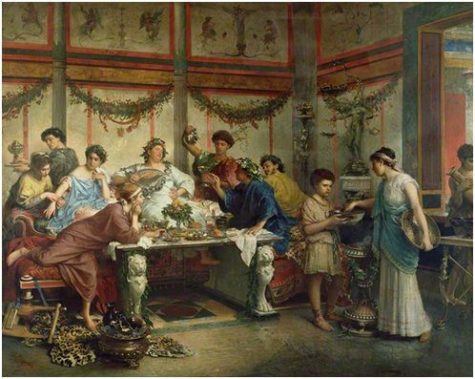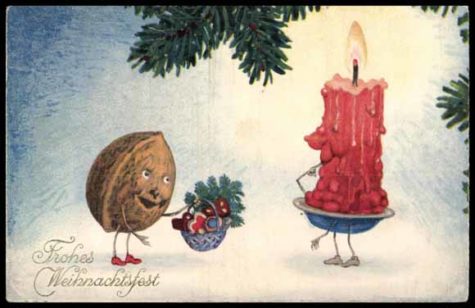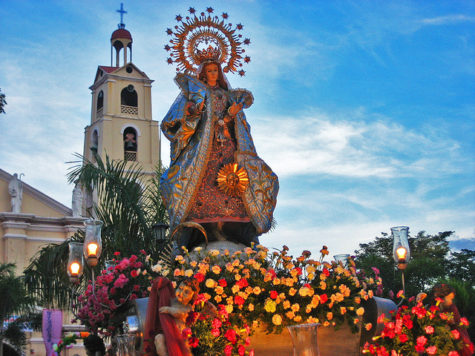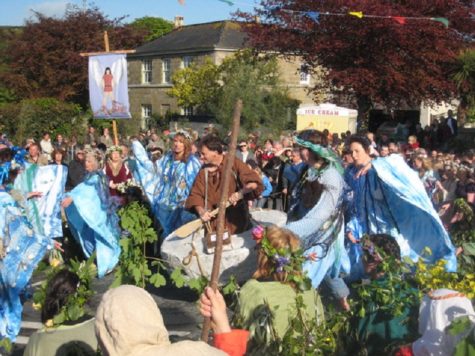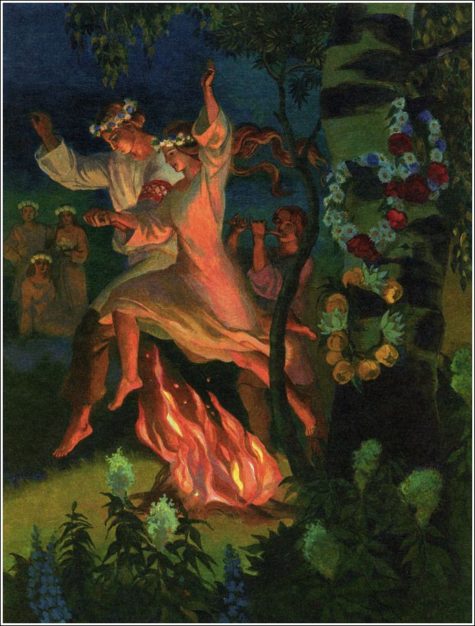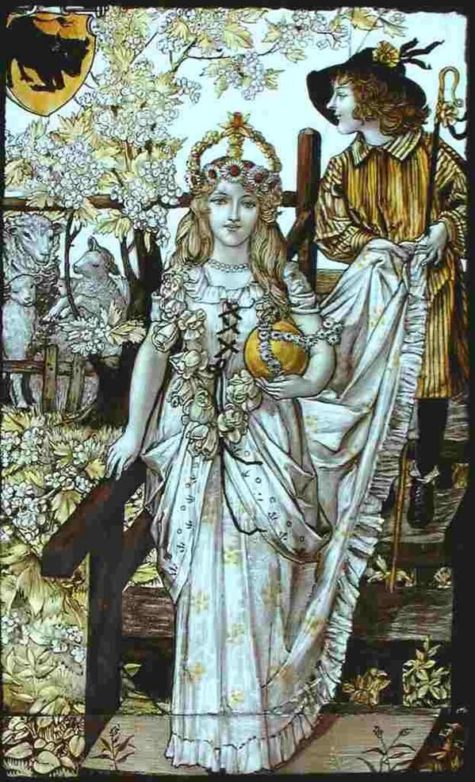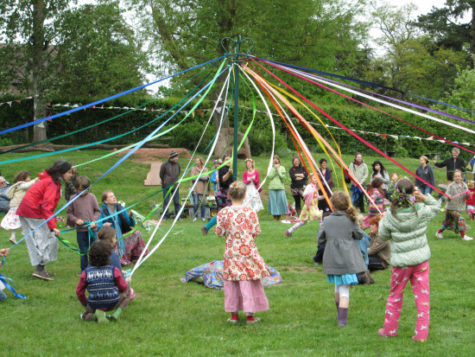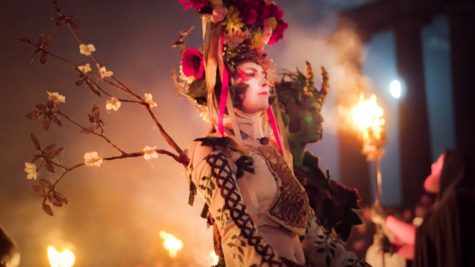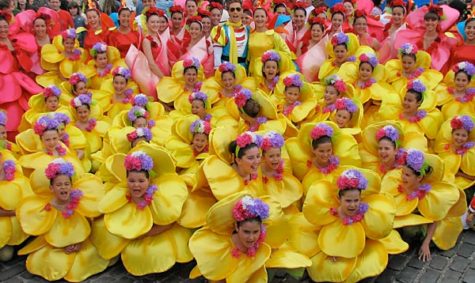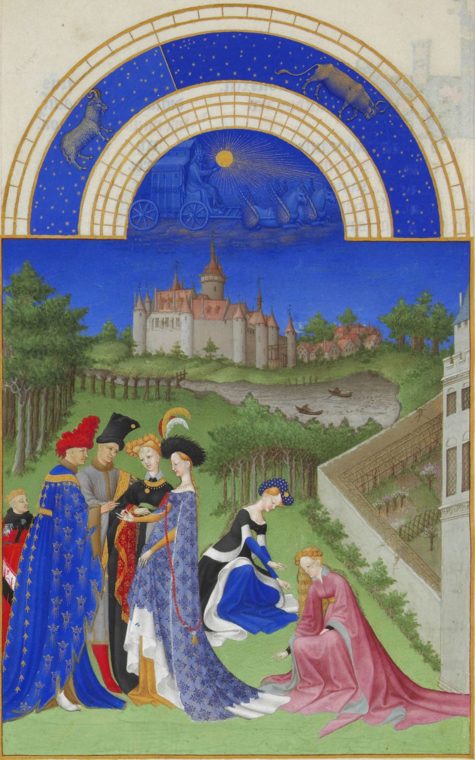Flowers
Anthesteria, held on February 11th, celebrates the maturing of the wine and the beginning of spring. It’s an Athenian festival in honor of Dionysus, god of the grape harvest, winemaking, and wine. The celebration lasted for three days in the month of Anthesterion (from the Hellenic calendar in ancient Attica).
The word Anthesteria is associated with “flower” or the “bloom” of the grape. A. W. Verrall (Journal of Hellenic Studies, xx., 1900, p. 115) wrote that it was a feast of “revocation” where the dead were recalled to the land of the living.
In ancient Greece, Anthesteria was the name of a festival during which the participants ritually expelled the Keres, evil female spirits, from their houses.
- The First Day
On the first day, called Pithoigia (opening of the casks), wine from the newly opened casks was offered to Dionysus and everyone in the household, including servants and slaves. The home and children were adorned with spring flowers.
- The Second Day
The second day, named Choës (feast of beakers), was for visiting. People dressed for the day, some even dressed as Dionysus. They spent the day visiting friends and family as well as the local drinking clubs were drinking games were held. Some folks offered wine to deceased relatives by pouring libations on the their tombs.
For the state, however, if was a formal day with secret ceremonies in one of the sanctuaries of Dionysus. The basilissa (or basilinna), wife of the archon basileus, would marry the god of wine in a special ceremony. She was assisted by fourteen Athenian matrons, called geraerae, who the basileus chose and swore to secrecy.
Both Pithoigia and Choës were considered unlucky and defiled days that necessitated atoning with libations. From this the souls of the dead would come up from the underworld and walked the earth. People chewed on buckthorn leaves and smeared tar on their doors to protect themselves from evil.
- The Third Day
The third day, Chytri (feast of pots), was a festival of the dead. Cooked legumes were offered to Hermes, son of Zeus, and he would make the souls of the deceased depart.
Sources:
The sending of cards is a fairly modern tradition, and used to be only for people that you would not be actually seeing. It was considered polite to give your greetings in person, whenever you could. However, today clever marketing from the manufacturers means that we tend to send cards to everyone, even when they live in the same house.
Whether you celebrate Yule, Christmas or another festival in December, you will probably be sending greeting cards. If you do this now then not only do you save a panic later, but also you will have the time to do a bit more than just scrawl your name. For those people with whom you are not in regular contact, try writing a few lines telling them what’s happening in your world at present. You could also enclose a small token, perhaps a pressed flower, to bring them cheer. Of course if you have the time it can be nice to make your own cards, and there are kits which can be bought to help with this.
For special people make your card into a spell for them. Decorate it with flowers or other plants which will bring them good fortune, like Fern, Oak, Holly, Poppy, Rose petals, or Violet. Alternatively, select plants for harmony, like Lavender, Passion Flower and Gardenia.
So get out your address book, dust off your memory and write your cards, now, before the festive season gets fully under way. You’ll thank yourself for it later! And don’t forget to have a few cards over, just in case there’s someone you forget.
From: The Real Witches’ Year
Flores de Mayo (Spanish for “flowers of May”) is a festival held in the Philippines in the month of May. It is one of the May devotions to the Blessed Virgin Mary and lasts for the entire month.
The Santacruzan (from the Spanish santa cruz, “holy cross”) is the ritual pageant held on the last day of the Flores de Mayo. It honors the finding of the True Cross by Helena of Constantinople (known as Reyna Elena) and Constantine the Great. Its connection with May stems from the old May 3 date of Roodmas, which Pope John XXIII abolished in 1960 in favour of the Feast of the Exaltation of the Cross on September 14
Regional Celebrations:
- In the Bicol Region, the ritual begins with the recitation of the rosary, and the last day is simply called the “katapusan”.
- In Western Visayas, the towns have their respective chapels where an image of the Virgin Mary is venerated and children gather to have a simple catechism and teachings about the life and story of Mary. They were also taught some prayers and songs recited only during the Flores de Mayo and the children offer flowers before the image of the Virgin Mary as a symbol of love, affection and veneration.
- Some churches and areas give children paper tickets for actively participating during the catechism and at the end of the month of May, the children redeem the value of the tickets which are school supplies ready for the school opening in June. Santacrusan is usually held during the last few days of May to coincide with the end of the catechism for children.
- Amongst the Tagalog people, the custom began after the publication of Mariano Sevilla’s translation of the devotional “Flores de María” or “Beautiful Flowers that in the Meditations in the Whole Month of May are Offered by Devotees to Mary Most Holy.”
- One famous May tradition in Batangas is the Luglugan, or nightly devotion and party honoring the Virgin Mary. Held in structures called tuklóng, devotees offer flowers and prayers to an image of Mary every night. After the prayer, the Hermanos or Hermanas for the day will give away treats to the participants, followed by the party. The Luglugan lasts for a month until the Tapusan (“ending”) which is marked with a Mass, a Santacruzan and procession of the Blessed Virgin Mary, and capped with a final Luglugan that lasts until the following morning.
- A Santacruzan is a religio-historical beauty pageant held in many cities, towns, and even in small communities throughout the Philippines during the month of May.
The Santacruzan Procession and Pageant
 One of the most colorful aspects of this festival, the pageant depicts the finding of the True Cross by Queen Helena, mother of Constantine the Great. Many movie and television personalities participate in the events and are featured in major santacruzan. This festival became part of Filipino traditions identified with youth, love, and romance.
One of the most colorful aspects of this festival, the pageant depicts the finding of the True Cross by Queen Helena, mother of Constantine the Great. Many movie and television personalities participate in the events and are featured in major santacruzan. This festival became part of Filipino traditions identified with youth, love, and romance.
Prior to the Santacruzan, a novena is held in honor of the Holy Cross. The procession itself commemorates the search of the Holy Cross by Reyna Elena and her son, Emperor Constantine. It is said to have roots in the joyous thanksgiving celebrations that followed the finding of the Holy Cross in Jerusalem and its translation to Constantinople (now İstanbul).
The procession is accompanied by the steady beat of a local brass band, playing and singing the Dios te salve (the Spanish version of the Hail Mary). Devotees hold lighted candles and sing the prayer as they walk. It is customary for males participating in the Santacruzan to wear the traditional Barong Tagalog and that the females wear any Filipiniana-inspired dress.
After the procession in some places, there is the pabítin game (in Cavite, it is called “agaw-bitin”) that serves as a culminating activity for the children. The pabítin is a square-shaped bamboo grille or frame to which goodies (candies, fruits, small trinkets, etc.) are tied with thin strings.
This grille in turn is tied to a long rope passed over a strong branch or pole some 2 metres above the ground. Children then gather under the frame as the it is slowly lowered, and they then jump as high as they could to grab the goodies while someone jerks it up and down repeatedly until all the prizes are gone.
Sometimes the palosebo (the local version of the greasy pole) is also played, where a tall bamboo pole is smeared with grease which participants must climb to get a small red banner or a bag with a prize, such as ₱500 or a higher amount.
For a Magickal Flores de Mayo
 From 360 Goddess, we have a different version of, and way to celebrate the Flores de Mayo. This can be celebrated any time during the month of May, or on the last day, as a sort of magickal Santacruzan.
From 360 Goddess, we have a different version of, and way to celebrate the Flores de Mayo. This can be celebrated any time during the month of May, or on the last day, as a sort of magickal Santacruzan.
- Themes: Offering; Prayer; Love; Devotion; Home; Relationships
- Symbols: Spring; May Blossoming Flowers
- Presiding Goddess: Sisina
About Sisina:
This Filipino goddess oversees the realms of orderliness, beauty, and love. Traditionally, she protects marriages against discord, but she may also be called upon to settle inner turmoil within your soul and restore self-love.
To do today:
People in the Philippines say good-bye to May with bouquets, flower offerings, and an array of sweet foods to honor the month’s sweetness and beauty. Sometimes they ask Sisina to join the festivities by setting a place for her at the table.
This particular custom appears in several other cultures and it is a simple, lovely way of honoring the goddess. Just leave a plate with a fresh flower on your dinner table. This draws Sisina’s presence, love, and peaceful nature to your home and family relationships. If you wish, also leave an offering of sweet bread or fruity wine in a special spot to thank her.
As you go about your normal routine today, take time to enjoy any flowers you see, and be very considerate of the special people in your life. Sisina will see the effort and continue blessing those relationships with harmony.
Sources: 365 Goddess and wikipedia
On 10 May, and again on 31 May, the Roman legions at Duro Europa celebrated the Rosalia. This again connects the flowers of Spring with rituals for the dead, only this time the rituals were performed by military units for their fallen comrades rather than for family members. We learn of this celebration first with a military calendar from Syria.
We do not know if the Rosalia was celebrated on the same dates by other legions throughout the Roman Empire, but we hear descriptions of the Rosalia in other texts suggesting that the Rosalia was common in the Roman army. Since the military calendar differs from other Roman calendars, it is possible that it represents a standard used among all legions. Then again each legion may have had its own schedule of festivals. However, since the month of May was dedicated to the dead, with Lemuria, it would seem reasonable that a military equivalent fell within the same month.
Here’s what we do know:
At the center of every Roman military camp there was a small shrine, the saculum. Inside this shrine the military standards were kept; these were the legion’s eagle and other standards for the maniples, cohorts, or vexilia. As with Roman temples, an altar was placed in front of the sacullum. At Rosalia the standards were brought forth and placed around the altar. They were crowned with wreaths of roses and a supplication, or thanksgiving, was performed before them. Beyond that one detail, nothing else is certain about this military ritual. But from its nature we can surmise something of its intent.
When someone died far from home, whether while serving in the army or away at sea, and thus was unable to be buried by his family, a cenotaphium would be erected as a dwelling place for his soul. His Lar (soul) was called three times and invited to enter the cenotaphium. For example, when Aeneas meets his deceased friend Deiphobus in the Underworld, he says,
“Then I myself on the Rhoetean shore erected a hollow tomb, and with loud voice thrice called upon thy spirit (Virgil, Aeneid).”
On the Nones (7 May) the tombs of ancestors were decorated with wreaths of roses. With their red hues, the roses were offered to the dead as a gesture of reviving them, or at least of remembering how they were once while still alive. The red roses were the flowers of Venus, and they were a reminder of the Garden of Venus where the souls of the dead, as animae, would dwell as Her children, like little cupids living in the Blessed Isles. So offering roses to the Manes was a way of wishing their safe journey on to the Garden of Venus.
There is not much doubt that the Rosalia was intended to honor the military dead. The standards were being adorned with roses in the same manner as tombs and cenotaphs. With the Romans I think you would also have to consider that they thought of the standards as cenotaphia that carried the Lares of the legion, who were the spirits of their fellow soldiers, into battle with them. This would also explain why the loss of the eagles would be taken as such a tragedy by Romans. Perhaps it also explains why the second century Christian writer Tertullian criticized this veneration of the standards.
The Rosalia was continued, however, even after the Roman army adopted Christianity. Something of the Rosalia remains even today in the parading of the colors of modern armies, where they are decorated with battle ribbons to commemorate where a unit has fought, as well as all the men who have served and died with the unit in the past. Laying a wreath of roses on the Tomb of the Unknown Soldier on Memorial Day is an echo of the Rosalia once performed by Roman legions.
Found at: Patheos
The May full moon is also known as the Flower Moon, Milk Moon, Corn Planting Moon, and Corn Moon. The energies around this moon are ones of health, romance, love and wisdom. We are encouraged to begin to take action on the things we’ve recently been planning.
Once April’s rains and winds have subsided, the sun begins to warm up the earth and we’re able to get the gardens planted. Thus May is the month we begin to sow our crops. Get out in the garden under a Flower Moon and put your hands into the soil. May’s Moon brings us energy of love, wisdom and health. Spring is a time of fertility, and May is a fiery month indeed — full of lust and passion! It’s called the month of the Hare’s Moon — and we all know what hares are busy doing in the spring.
Correspondences:
- Colors: Red, orange, yellow
- Gemstones: Ruby, garnet, amber, Apache tear
- Trees: Hawthorn, rowan
- Gods: Kali, Priapus, Cernunnos, Flora
- Herbs: Cinnamon, members of the mint family
- Element: Fire
Gems and oils to boost the energy of the Hare’s Moon
- Gemstones: Malachite, Jade, Emerald, Peridot or any other green-hued stones.
These gems help enhance the energy of the heart chakra, which governs our compassion, generosity, love and harmony. If you need a boost in any of these areas, simply slip a green stone into your pocket, or put on a piece of green-gemmed jewelry.
- Essential Oils: Eucalyptus, Thyme, Sandalwood, Pine, Melissa, Bergamont.
These oils will help you connect with your unconscious mind and set the intention of love, wisdom and compassion
Celebrating The May Full Moon
The May full moon is a time when we begin to really notice more light in our lives. The days are longer, the grass is green and the flowers are starting to bloom. The energy at this time is playful and light, energetic and buoyant. If you want to really celebrate this moon and the energy it brings, you can do fun things like:
- host a pot-luck with a spring theme
- visit your local elementary school and volunteer during art class
- light a green candle and meditate on your thankfulness for the feeling of renewal and rejuvenation.
Other ideas:
Another great way to connect with the Hare’s Moon is to bless some seeds, seedlings or garden plants, and then plant them. Doing this involves intentionally adding positive energy to these plants, and then nurturing their growth and health. This is a powerful symbolic exercise that will help you focus your energy on intentionally giving “good vibes” to your environment. Doing this will make you feel empowered, positive and loving.
This is also a good time to work on magic related to careers and jobs. Thinking about switching to a new position, or perhaps trying a new field altogether? Want to take a class or get your degree? Take the seeds you’ve planted last month, and allow them to bloom and grow in your favor. Do some fire divination this month to help guide you on your way.
source: PaganWiccan
For the purpose of your magical escapades, the theme is definitely blossoming and liveliness. Use as many flower parts as possible in spells and rituals, and go outside frequently to get closer to nature. Energies emphasized by this month include creativity, inventiveness, fertility, health, and metaphysically “spring cleaning” any area of your life or sacred space.
Bring me my drum and bring me my cymbal,
Bring forth the sustrum, bring forth the timbal.
Dance now for Hathor, celebrate beauty,
dance in Her honor, sing for our lady.
May gets its name from the Roman goddess Maia, who embodies the earth’s renewal during spring. Next to New Year’s Eve, May Day was among the most popular holidays in the old world, marking the time when the sun’s warmth and nature’s fertility began appearing in the land. Later, well over one hundred nations chose to celebrate Labor Day on May 1, giving everyone a much-needed rest from winter’s tasks.
The Greek goddess Maia, the most important of the Seven Sisters (the Pleiades) and said to be the mother of Hermes, gave the name to this month. Some form of this goddess’s name was known to people from Ireland to as far away as India. The Romans called her Maius, goddess of Summer and honored her at the Ambarvalia, a family festival for purification and protection of farm land.
In the Celtic cultures, May was called Mai or Maj, a month of sexual freedom. Green was worn during this month to honor the Earth Mother. May 1 was the Celtic festival of Beltane, a festival celebrating fertility of all things. Cattle were drivien through the Beltane bonfires for purification and fertility. In Wales, Creiddylad was connected with this festival and often called the May Queen. The maypole and its dance is a remnant of these old festivities.
The Sheila Na Gig is still seen carved in the decorations of many Irish churches. This goddess figure is a grotesque, often emaciated, woman shown squatting and holding wide her private parts. Many Irish still know her as the protector of the poor and hang old clothes on hawthorn bushes on May 4th. This is believed to avert poverty. It is possible that the Australian term “Sheila,” used as a name for any woman, refers to this ancient deity and her carvings.
Bona Dea, the Roman Good Goddess, had her festival on the night between may 2nd and 3rd. No men were allowed to attend.
The Roman festival of Lemuria was to placate and remember the Lemures, or the wandering spirits of the dead. Each family performed its own private ceremonies, which ended with taking gifts to the graves. For those who had died and had no graves, the head of the household walked barefoot through the house, casting nine black beans behind him.
The Greeks had a special festival for the god Pan during May. Pan was a wild looking deity, half man, half goat. As a token of his frequent sexual adventures, he was shown with an erect penis. Pan invented the syrinx, or pan-pipes, made out of reeds. Originally, he was not an oppressor of women, but their loving companion.
May 19-28 was the solemn Greek festival called Kallyntaria and Plynteria. This was devoted to the cleaning and freshening of sacred statures and temples. The statues, small enough to be moved, were taken to a nearby river or lake and washed until clean. This was serious business with no singing or merry-making.
At the end of the month was a Roman celebration honoring the Underworld Queen Prosperina and her consort Pluto. Proserpina ruled over the resting place of the shades (souls), but her kingdom was connected with more than death. Pluto was also known as the deity of hidden wealth.
In Finland, May 1 was celebrated as Rowan Witch Day, a time of honoring the goddess Rauni, who was associated with the mountain ash or rowan. Twigs and branches of the rowan were, and still are, used as protection against evil in this part of the world. Some sources list Rauni as a god.
The Slavonic-Russian cultures had a similar, but longer, festival celebrating merriment, rivers, and well-being. This occured between May 25 and June 25. Originally it honored the goddess Lada, who later was changed to the god Lado.
Mugwort was a sacred herb in China and Europe. As part of the celebration on May 5, the Chinese made dolls out of the leaves. They hung these dolls above gates and doors to repel negative influences and entities.
In Tibet, an old Nature festival for the beginning of Summer and the rain deities became a celebration of Buddha’s death and his attainment of Buddha-hood. The attainment festival occurred on May 8, while celebration of Buddha’s death was on May 15. Deceased relatives were prayed for at this time.
The Incas held Aymoray Quilla or Hatun Cazqui, which was the Great Cultivation.
From: Moon Magick
The Furry Dance, also known as The Flora (or incorrectly as the Floral Dance), takes place in Helston, Cornwall, and is one of the oldest British customs still practiced today. The Dance takes place every year on May 8 (or the Saturday before if May 8 falls on a Sunday or Monday), and is a celebration of the passing of Winter and the arrival of Spring.
The dance is very well attended every year. Winter’s gone, so everybody’s out in the streets to celebrate the new life springing up all around. It seems like the whole of Cornwall is lining the streets, all freshly decorated with colourful flowers
The four dances and a Hal-an-Tow (a mystery play), spread across the day, starting with the first dance at 7.00 am, continuing with the children’s dance at 10.00 am, then the midday dance and culminating in the evening dance at 5.00 pm. Of these, the midday dance is perhaps the best known: it was traditionally the dance of the gentry in the town, and today the men wear top hats and tails while the women dance in their finest frocks.
The Dance twists and turns its way through this ancient Cornish town and the route doesn’t change, even if that means that the Flora Dance has to traipse through people’s houses, across their gardens or straight through the shops.
The whole town is decorated with greenery, many of the people are wearing greenery outfits and the Town Band play all day long, providing music to the dancers, they have a splash of greenery in their hats too, you’ll notice this is Lily of the Valley, which is Helston’s symbolic flower. The gentlemen wear it on the left, with the flowers pointing upwards, and the ladies wear it upside down on the right.
Originally, most likely, a May Day celebration, it was moved to May 8th to commemorate the town’s patron saint, St Michael, who is said to have saved the town from what appears to be a meteorite hit in AD 495, you can still see the boulder that crashed down as it’s still visible as a wall in the Angel Yard.
Source: Cornish Festivals
Have Your Own Furry Dance:
The Furry Dance is an ancient festival that rejoices in spring’s warmth and beauty. To bring this energy into your life, it’s customary to dance with a partner. In fact, the more people you can get dancing, the more fortunate the energy! Usually this is done on the streets throughout a town as a show of regional unity, but when propriety won’t allow such a display, just dance around a room together instead. Don’t worry about the steps – just do what feels right.
- Themes: Unity; Joy; Luck
- Symbols: Flowers; Triangle
- Presiding Goddess: Tanat
In Cornwall, Tanat is the mother goddess of fertility who has given all her attention to nursing spring into its fullness. She also staunchly protects her children (nature and people) so that our spirits can come to know similar fulfillment.
Wearing something with floral or triangular motifs (guys, wear a necktie, and gals, pull out a square scarf and fold it crosswise) activates Tanat’s happiness in your life and in any region where you have the token on today. As you don the item, say:
Liberate happiness in and around,
by Tanat’s blossoming power, joy will be found!
Or if you want to use the same thing to generate unity and harmony, use this incantation:
Harmony and unity,
Tanat’s blessings come to me.
From: 365 Goddess
The first of May is Beltane or May Day, a time to celebrate the leaping fires of passion. Traditionally celebrated on April 30, (May eve), it marks the height of spring and the flowering of all life. Beltane is a festival of sensuality, sexuality, flowers and delight. It is a traditional time to make love, preferably outdoors.
Beltane is the time when fairies return from their winter rest, carefree and full of mischief and delight. On the night before Beltane, in times past, folks would place rowan branches at their windows and doors for protection. If you do not wish the fairies to visit, do the same! This is also a perfect time for night or predawn rituals to draw down power to promote fertility in body and mind.
At Beltane, the Pleiades star cluster rises just before sunrise on the morning horizon. The Pleiades is known as the seven sisters, and resembles a tiny dipper-shaped pattern of six moderately bright stars in the constellation of Taurus, near the shoulder. Watch for it low in the east-northeast sky, just a few minutes before sunrise.
There are many lovely old customs associated with this time. Here are some simple ideas for celebrating this wild red time of year:
- Make a garland or wreath of freshly picked flowers and wear it in your hair.
- Dress in bright colors, especially hot pink or crimson, the traditional colors of Beltane, or wear green all day (and nothing all night!)
- Hang fruits and baked goodies from trees and bushes for later feasting.
- Build a Beltane fire: leap over it to cleanse yourself, or state your desires and let the fire carry them upward.
- Leap over your garden rows (or house plants), sharing joyous energy.
- Make a ‘May gad’: peel a willow-wand and twine cowslips or other flowers around it.
- Throw a May Day party and feast on May wine and food till the dawn. Turn a broomstick into a maypole and see how many people you can get to dance round it.
- Make love in the woods, in your garden, outside – at night.
- Watch the sunrise. Pack a picnic breakfast, a blanket, and some sweaters; and head out before dawn. Unpack your picnic on a hill with an unobstructed view and enjoy the early morning rays as the sun peaks over the horizon.
- Make a flower feast! Freeze edible flowers in your ice cubes. Add edible flowers to your salad. Candy flowers to decorate your dessert.
- Make a May basket. Fill it with flowers, food, ribbons, and fun. Leave it on a doorstep of a lover or friend, or someone who cannot get outside, such as an invalid or elderly person.
- Make a daisy chain and cast it into one of the lakes to please the water spirits.
- Rise at dawn on May Day and wash in the morning dew: The woman who washes her face in it will be beautiful, the man who washes his hands will be skilled at knots and nets (always a useful skill for students).
- Twist a Rowan sprig into a ring and look through it- tonight is one of the three in the year when the uninitiated can see the faeries.
- Create a May Day altar with a mirror, a small maypole, a phallic shaped candle, a daisy chain and springtime flowers.
- Light a fire or candle on the top of a hill and make a wish as you jump over it (for authenticity, you can try this sky clad, it would also be amusing for any passing late-night dog walkers!)
- Perfume your house with delicate scent of woodruff, a tiny, star-like flower that blooms around this time in the Northern Hemisphere.
- Embrace the ones you love. Hugs and kisses all around.
Holidays are days made holy by the attention we pay them. Simple practices such as the ones listed above remind us that we too dance to the natural rhythms of the earth.
Honor The May Queen
Make an offering of a floral crown, or a libation of honey and milk, to the Queen of the May during your Beltane prayers.
The leaves are budding across the land
on the ash and oak and hawthorn trees.
Magic rises around us in the forest
and the hedges are filled with laughter and love.
Dear lady, we offer you a gift,
a gathering of flowers picked by our hands,
woven into the circle of endless life.
The bright colors of nature herself
blend together to honor you,
Queen of spring,
as we give you honor this day.
Spring is here and the land is fertile,
ready to offer up gifts in your name.
we pay you tribute, our lady,
daughter of the Fae,
and ask your blessing this Beltane.
Make A Maypole for Beltane
This isn’t as difficult as you might think. Purchase a twenty foot wood pole from your local hardware store, or make a shorter one with a yardstick, broomstick, or even a twig. Set it up in your backyard.
Invite a group of friends, and ask each one to bring a 2 inch by 20 foot length of brightly colored ribbon (or whatever the length of your pole). Alternatively, you could provide ribbons of various colors. At the top of the pole affix the different colored ribbons – one for each person.
When your guests have assembled, have them each choose a ribbon and make a wish upon it.(For example, “I choose this red ribbon for more passion in my life.”) Everyone grabs their ribbon, and the dancing begins. (Make sure to have extra ribbons just in case!) Dance around the Maypole entwining your ribbons together. And then feast on May wine and food till the dawn.
More About Beltane
For the Celts, Beltane marked the beginning of the pastoral summer season when the herds of livestock were driven out to the summer pastures and mountain grazing lands. In modern Irish, Mí na Bealtaine (‘month of Bealtaine’) is the name for the month of May. The name of the month is often abbreviated to Bealtaine, with the festival day itself being known as Lá Bealtaine. The lighting of bonfires on Oidhche Bhealtaine (‘the eve of Bealtaine’) on mountains and hills of ritual and political significance was one of the main activities of the festival.
Beltane is a cross-quarter day, marking the midpoint in the Sun’s progress between the vernal equinox and summer solstice. Since the Celtic year was based on both lunar and solar cycles, it is possible that the holiday was celebrated on the full moon nearest the midpoint between the vernal equinox and the summer solstice. The astronomical date for this midpoint is closer to May 5 or May 7, but this can vary from year to year.
In Irish mythology, the beginning of the summer season for the Tuatha Dé Danann and the Milesians started at Bealtaine. Great bonfires would mark a time of purification and transition, heralding in the season in the hope of a good harvest later in the year, and were accompanied with ritual acts to protect the people from any harm by Otherworldly spirits, such as the Sídhe.
Like the festival of Samhain, opposite Beltane on Oct. 31, Beltane was a time when the Otherworld was seen as particularly close at hand. Early Gaelic sources from around the 10th century state that the druids of the community would create a need-fire on top of a hill on this day and drive the village’s cattle through the fires to purify them and bring luck (Eadar dà theine Bhealltainn in Scottish Gaelic, ‘Between two fires of Beltane’).
In Scotland, boughs of juniper were sometimes thrown on the fires to add an additional element of purification and blessing to the smoke. People would also pass between the two fires to purify themselves. This was echoed throughout history after Christianization, with lay people instead of Druid priests creating the need-fire.
The festival persisted widely up until the 1950s, and in some places the celebration of Beltane continues today. A revived Beltane Fire Festival has been held every year since 1988 during the night of 30 April on Calton Hill in Edinburgh, Scotland and attended by up to 15,000 people (except in 2003 when local council restrictions forced the organizers to hold a private event elsewhere).
Wiccans and Wiccan-inspired Neopagans celebrate a variation of Beltane as a sabbat, one of the eight solar holidays. Although the holiday may use features of the Gaelic Bealtaine, such as the bonfire, it bears more relation to the Germanic May Day festival, both in its significance (focusing on fertility) and its rituals (such as maypole dancing). Some Wiccans celebrate ‘High Beltaine’ by enacting a ritual union of the May Lord and Lady.
~Information from various sources including Paganwiccan
The Romans had a celebration for just about everything. Certainly, any deity worth their salt got a holiday of their own, and Flora was no exception. She was the goddess of spring flowers and vegetation, and one of many fertility goddesses. In fact, she was so well respected as a fertility deity that she was often seen as a the patron deity of Roman prostitutes.
Her holiday originated around 235 b.c.e. It was believed that a good festival ensured that Flora would protect the blooming flowers around the city. However, at some point the celebration was discontinued — but it clearly took its toll when wind and hail did some serious damage to the flowers of Rome. In 173 b.c.e., the Senate reinstated the holiday, and renamed it the Ludi Floralis, which included public games and theatrical performances.
The Floralia took place during the five days between April 28 and May 3. Citizens celebrated with drinking and dancing. Flowers were everywhere, in the temples and on the heads of revelers. Anyone making an offering to Flora might give her a libration of milk and honey.
source: PaganWiccan
April gets its name from the goddess Aprilis, who is the Romans’ version of Aphrodite. Her name means “to open,” which is exactly what Aprilis does… she opens the path to playfulness and the way to personal enrichment.
We all know the rhyme “April showers bring May flowers.” So consider what energies you want Aprilis to sprinkle on you this month for personal flowering. Overall, any magical efforts aimed toward growth, love, pleasure, improvements, and developing one’s inner child will benefit from working this month.
Because the Christian holiday of Easter sometimes falls in this month, the Anglo-Saxons and Franks called it Easter Month; of course, the word Easter comes originally from the name of the Pagan goddess Eostre, deity of Spring, fertiilty, and new life. The Romans called this month Aprilis, a time of unfolding leaves and flowers.
April was the second month of the Roman calendar, before January and February were added by King Numa Pompilius about 700 BC. It became the fourth month of the calendar year (the year when twelve months are displayed in order) during the time of the decemvirs about 450 BC, when it also was given 29 days April is commonly associated with the season of spring in the Northern hemisphere and autumn in the Southern hemisphere.
Correspondences for April:
- Nature Spirits: Plant faeries
- Herbs: Basil, chives, dragons blood, geranium, thistle
- Colors: Crimson red, gold
- Flowers: Daisy, sweetpea
- Scents: Pine, bay, bergamot, patchouli
- Stones: Ruby, garnet, sard
- Trees: Pine, bay, hazel
- Animals: Bear, wolf
- Birds: Hawk, magpie
- Deities: Kali, Hathor, Anahita, Ceres, Ishtar, Venus, Bast
- Birth stone: Diamond
- Birth flower: Daisy or sweet pea
- Zodiac Signs: Aries (until April 19) and Taurus (April 20 onwards).
Power Flow:
Energy into creating and producing; return balance to the nerves; change; self confidence; self reliance; take advantage of opportunities; work on temper and emotional flare-ups and selfishness.
April Festivities:
The Megalesia of Cybele, who was also known as Magna Mater (Great Mother) in both Phyrgia and Rome, celebrated the arrival of this goddess in Rome. In 204 BCE, Rome was in the midst of a great war with Hannibal. Things were going very badly for the Roman legions. Finally, the Romans sent a delegation to the Oracle at Delphi for an interpretation of their sacred Sibylline Books. This passage said that foreing invaders could only be driven away when the Mother of Mount Ida was transferred from Pessinus to Rome.
The oracle sent the delegation to the king of Pergamum in Asia Minor, where they were told that a black meteroite embodying the spirit of Cybele was. Pine trees from Mt. Ida, sacred to the goddess, were made into a ship, and the stone was transported from one sanctuary to another until it reached Rome. In about a year, Hannibal left Italy forever.
The Japanese Flower Festival has now become a celebration of Buddha’s birth. In the older celebration, however, the people gathered wildflowers for the family shrine. Those in the Shinto faith placed wooden markers on the graves and said prayers.
The Roman festival of Cerealia celebrated the return of Proserpina to the Earth goddess Ceres. Our word “cereal” comes from the name Ceres. It was the time of planting grain. Ceres was the Roman equivalent to the Greek goddess Demeter.The festival of Cerealia was held for seven days from mid-to-late April, but exact dates are uncertain.
Feriae Latinae was also held in April, with the date varying. Other ancient Roman observances include Veneralia, Fordicidia, Parilia, Vinalia Urbana, Robigalia, and Serapia.
The Egyptians called their land Khemennu, or Land of the Moon. Plutarch wrote that they believed the Moon to be the Mother of the Universe. Although the goddess Bast was primarily considered to be a deity of the gentle Sun, she was also connected with the Moon.
Floralia was held April 27 during the Republican era, or April 28 on the Julian calendar, and lasted until May 3. However, these dates do not correspond to the modern Gregorian calendar. The Floralia is still celebrated in many Central and Eastern European countries. It is a time to honor the goddess of flowers. People dress in gaily decorated costumes and wear flowers in their hair. Secretly delivering baskets of flowers on May Day is a remnant of this old festival.
During this month was also the Incan Ayrihua or Camay Inca Raymi, the Festival of the Inca.
April Weather Lore
It is said that if early April is foggy,
rain in June will make lanes boggy.
April weather:
rain and sunshine, both together.
April showers bring May flowers.
A dry April
Not the farmer’s will.
April wet
Is what he would get.
“If it rains on Easter Sunday,
it will rain on the next seven Sundays.”
More April Lore:
St George’s day is the twenty-third of the month; and St Mark’s Eve, with its superstition that the ghosts of those who are doomed to die within the year will be seen to pass into the church, falls on the twenty-fourth.
In China the symbolic ploughing of the earth by the emperor and princes of the blood took place in their third month, which frequently corresponds to April. In Finnish April is huhtikuu, meaning slash-and-burn moon, when gymnosperms for beat and burn clearing of farmland were felled.
In Slovene, the most established traditional name is mali traven, meaning the month when plants start growing.
The month Aprilis had 30 days; Numa Pompilius made it 29 days long; finally Julius Caesar’s calendar reform made it again 30 days long, which was not changed in the calendar revision of Augustus Caesar in 8 BC.
The Lyrids meteor shower appears on April 16-April 26 each year, with the peak generally occurring on April 22. Eta Aquariids meteor shower also appears in April. It is visible from about April 21 to about May 20 each year with peak activity on or around May 6. The Pi Puppids appear on April 23, but only in years around the parent comet’s perihelion date. The Virginids also shower at various dates in April.
The theme for April
The theme for April is momentum. When something has momentum it takes more of an effort to change its course, and less of an effort to move it in the direction it is already going. This is a tricky month as momentum will take hold in whatever direction you happen to be putting your focus and energy.
For example, if you are in a bad mood, that mood is in danger of gathering momentum. If you are focused on a creative project of your choosing, it will also gather momentum. It is very important that you are focused on the things you want in your life at this time for they are the ones that will gather momentum.
This is a highly creative and productive time. The challenge will be to stay directed and to have the discipline to move yourself out of situations and away from negativity that you would rather not be gathering momentum around. This will take discernment, the use of good boundaries and a commitment to some truth telling about what serves you and what does not.
If you find yourself in a downward spiral where everything seems to be falling apart in a big way, you may need to look at the truth of allowing something you have been holding onto to dissolve and leave your life. You may finally have the momentum to move yourself out of a situation that is not healthy or serving. On the other hand, a creative project that is aligned with spirit may have just been waiting for such a time to take off.
From:
- Moon Magick
- Lena Stevens, The Power Path
- Various other sources
